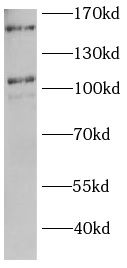Products
HYOU1 antibody
Category:
- SPECIFICATIONS
- Product Name
- HYOU1 antibody
- Catalogue No.
- FNab10247
- Size
- 100μg
- Form
- liquid
- Purification
- Immunogen affinity purified
- Purity
- ≥95% as determined by SDS-PAGE
- Clonality
- polyclonal
- Isotype
- IgG
- Storage
- PBS with 0.02% sodium azide and 50% glycerol pH 7.3, -20℃ for 12 months(Avoid repeated freeze / thaw cycles.)
Immunogen
- Immunogen
- Hypoxia up-regulated protein 1
- Alternative Names
- GRP-170 antibody, Grp170 antibody, HSP12A antibody, ORP-150 antibody, ORP150 antibody
- UniProt ID
- Q9Y4L1
- Observed MW
- 110kDa,150kDa
Application
- Tested Applications
- ELISA, WB, IHC
- Recommended dilution
- WB: 1:500 - 1:2000; IHC: 1:50 - 1:200
Validated Images
 MCF7 cells were subjected to SDS PAGE followed by western blot with FNab10247(HYOU1 antibody) at dilution of 1:1000
MCF7 cells were subjected to SDS PAGE followed by western blot with FNab10247(HYOU1 antibody) at dilution of 1:1000
 Immunohistochemistry of paraffin-embedded mouse testis tissue slide using FNab10247(HYOU1 Antibody) at dilution of 1:100
Immunohistochemistry of paraffin-embedded mouse testis tissue slide using FNab10247(HYOU1 Antibody) at dilution of 1:100
- Background
- The protein encoded by this gene belongs to the heat shock protein 70 family. This gene uses alternative transcription start sites. A cis-acting segment found in the 5' UTR is involved in stress-dependent induction, resulting in the accumulation of this protein in the endoplasmic reticulum (ER) under hypoxic conditions. The protein encoded by this gene is thought to play an important role in protein folding and secretion in the ER. Since suppression of the protein is associated with accelerated apoptosis, it is also suggested to have an important cytoprotective role in hypoxia-induced cellular perturbation. This protein has been shown to be up-regulated in tumors, especially in breast tumors, and thus it is associated with tumor invasiveness. This gene also has an alternative translation initiation site, resulting in a protein that lacks the N-terminal signal peptide. This signal peptide-lacking protein, which is only 3 amino acids shorter than the mature protein in the ER, is thought to have a housekeeping function in the cytosol. In rat, this protein localizes to both the ER by a carboxy-terminal peptide sequence and to mitochondria by an amino-terminal targeting signal. Alternative splicing results in multiple transcript variants.



